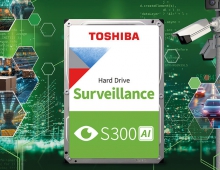
Toshiba's new Dual-layer, single-sided, Blue-Laser Rewritable Optical Disk needs only current production facilities
Tokyo-Toshiba Corporation today announced that it has developed a working
prototype of a high capacity dual-layer, single-sided, blue-laser rewritable
optical disk. The new disk enjoys key advantages in that it can easily be
brought to mass production with only minimal adjustments to current DVD
production facilities, and that its current capacity can be increased
significantly. The new disk is also expected to promote lower production
costs for next generation optical disks, while offering simple
implementation of backward compatibility with today's generation of DVD
formats.
Details of the new disk and its technology will be presented at Optical Data
Storage 2003, to be held from May 11 to 14 at the Hyatt Regency of
Vancouver, BC Canada.
The market is starting to move toward next generation DVD format compatible with high definition TVs and the ever-increasing capacity of broadband networks. The DVD Forum, the 215-company strong international association of hardware manufacturers and content providers, is taking the lead in defining such formats.
In August 2002, Toshiba and NEC jointly proposed to the Forum a format for a next generation high-definition system based on a high-capacity, blue-laser DVD. This is now under discussion. That format covers a 15GB single-layer, single-sided read-only disk, a 30GB dual-layer, single-sided, read-only disk, and a 20GB single-layer, single-sided read-and-write disk. These capacities significantly improve on the 8.5GB capacity of current dual-layer, single-sided read-only DVD disks and 4.7GB single-layer, single- sided read-and-write DVD disks.
The proposed format utilizes a short wavelength blue laser and the same disk structure used in current DVDs-back-to-back bonding of two 0.6mm thick, 120mm disks. This approach not only supports continued use of today's DVD disk manufacturing equipment, it also delivers higher production yields than alternative disk structures based on stacked disks. Toshiba-NEC format also employs an objective lens with a numerical aperture of 0.65, very close to that of current DVD.
Since proposing the format, Toshiba has continued development work and has now achieved and demonstrated the practicality of a high capacity 36GB dual-layer, single-sided read-and-write disk that can be applied to both consumer electronic and computer applications.
Toshiba's new high-capacity dual layer disk employs Germanium-Tellurium-rich Germanium-Antimony-Tellurium-Bismuth (GeSbTeBi) alloy recording layers that support improved signal processing and erasability. The disk's dual-layer structure has a high level of manufacturability and a capacity that can be pushed to higher levels.
In summing up the advantages of the new disk, Toshiba noted pluses in the manufacturing process from maximizing similarities with current DVD. The working prototype allows use of the same manufacturing infrastructure as current DVD, supporting manufacturers' by limiting the need for new investments, while also minimizing disk production costs and delivering high yields. The new disk also assures backward compatibility with current CDs and DVDs, and supports fabrication of disks that do not need a cartridge-an essential feature for slim drives that can be integrated into portable equipment.
Toshiba will present the disk technology at Optical Data Storage 2003 at 9:45 on May 13. The company will propose the dual-layer format to the DVD Forum in the latter half of this year.
The market is starting to move toward next generation DVD format compatible with high definition TVs and the ever-increasing capacity of broadband networks. The DVD Forum, the 215-company strong international association of hardware manufacturers and content providers, is taking the lead in defining such formats.
In August 2002, Toshiba and NEC jointly proposed to the Forum a format for a next generation high-definition system based on a high-capacity, blue-laser DVD. This is now under discussion. That format covers a 15GB single-layer, single-sided read-only disk, a 30GB dual-layer, single-sided, read-only disk, and a 20GB single-layer, single-sided read-and-write disk. These capacities significantly improve on the 8.5GB capacity of current dual-layer, single-sided read-only DVD disks and 4.7GB single-layer, single- sided read-and-write DVD disks.
The proposed format utilizes a short wavelength blue laser and the same disk structure used in current DVDs-back-to-back bonding of two 0.6mm thick, 120mm disks. This approach not only supports continued use of today's DVD disk manufacturing equipment, it also delivers higher production yields than alternative disk structures based on stacked disks. Toshiba-NEC format also employs an objective lens with a numerical aperture of 0.65, very close to that of current DVD.
Since proposing the format, Toshiba has continued development work and has now achieved and demonstrated the practicality of a high capacity 36GB dual-layer, single-sided read-and-write disk that can be applied to both consumer electronic and computer applications.
Toshiba's new high-capacity dual layer disk employs Germanium-Tellurium-rich Germanium-Antimony-Tellurium-Bismuth (GeSbTeBi) alloy recording layers that support improved signal processing and erasability. The disk's dual-layer structure has a high level of manufacturability and a capacity that can be pushed to higher levels.
In summing up the advantages of the new disk, Toshiba noted pluses in the manufacturing process from maximizing similarities with current DVD. The working prototype allows use of the same manufacturing infrastructure as current DVD, supporting manufacturers' by limiting the need for new investments, while also minimizing disk production costs and delivering high yields. The new disk also assures backward compatibility with current CDs and DVDs, and supports fabrication of disks that do not need a cartridge-an essential feature for slim drives that can be integrated into portable equipment.
Toshiba will present the disk technology at Optical Data Storage 2003 at 9:45 on May 13. The company will propose the dual-layer format to the DVD Forum in the latter half of this year.





















